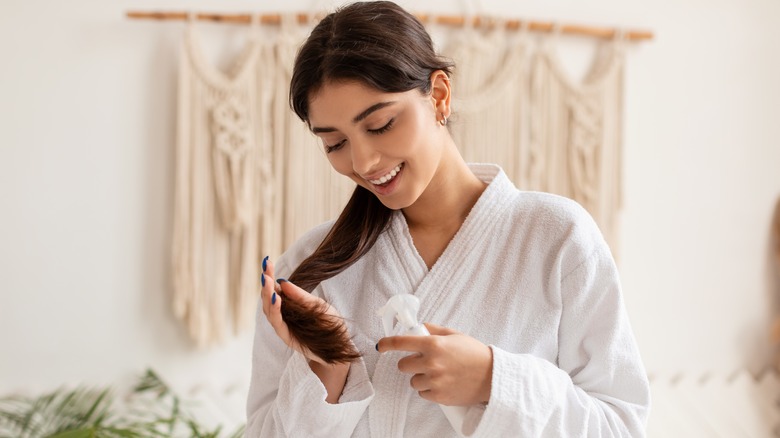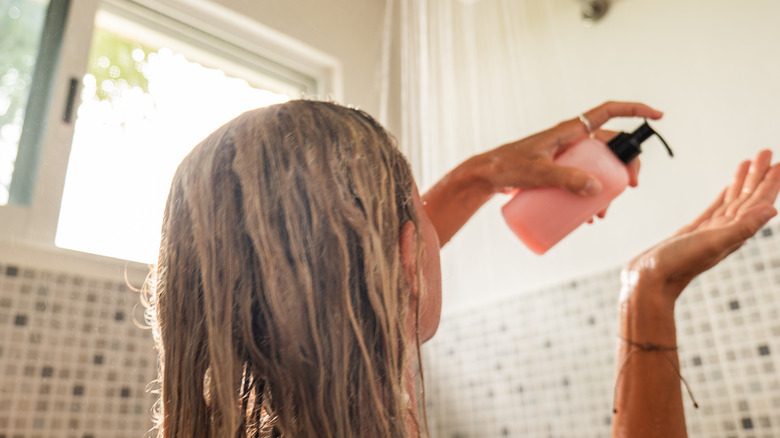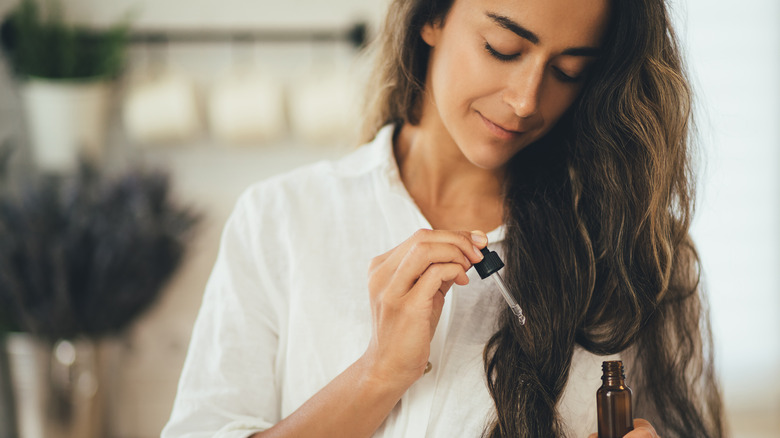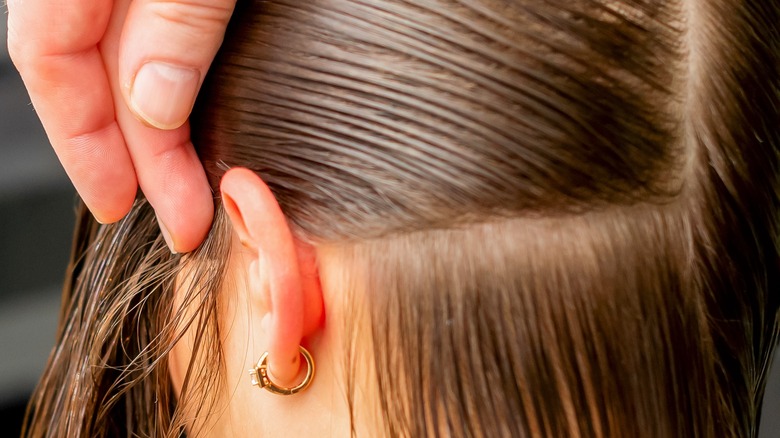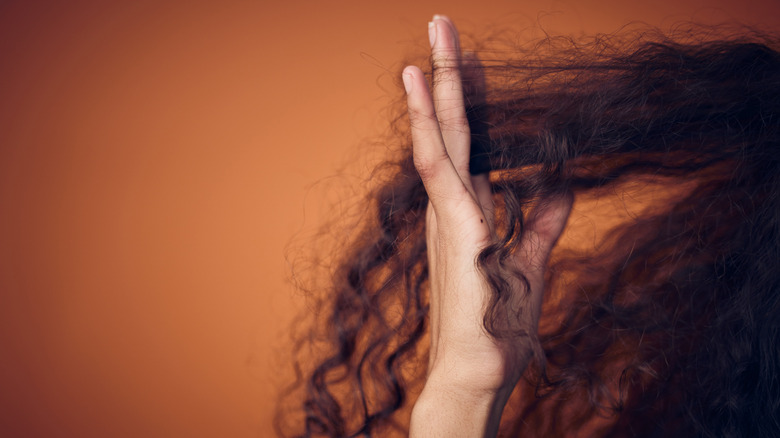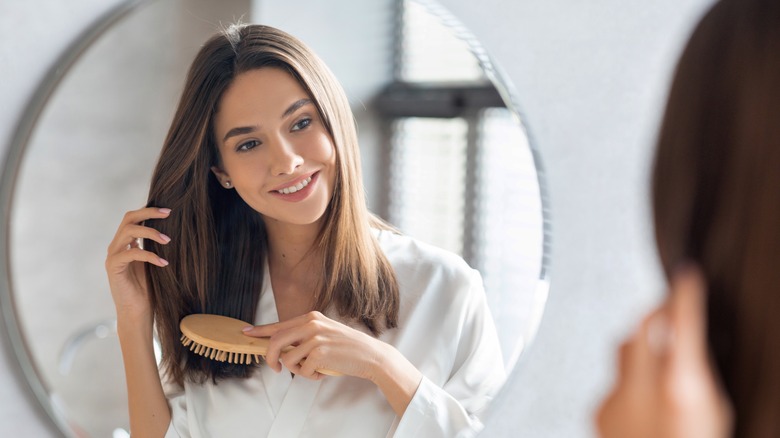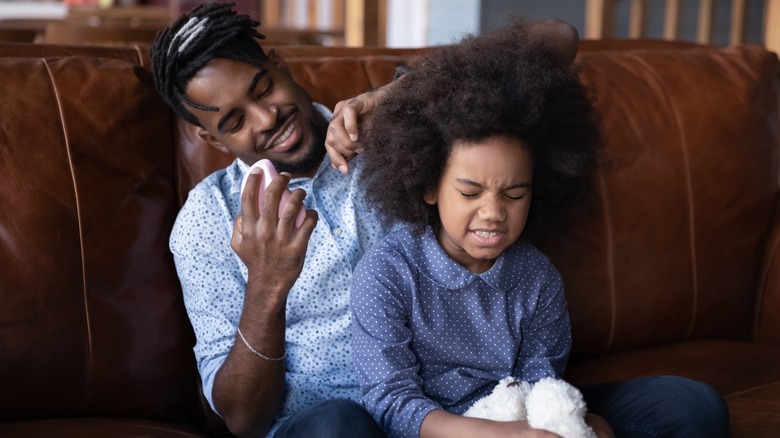All The Detangling Tips You'll Ever Need - No Matter Your Hair Type
Tangles. They don't look good, they don't feel good, but did you know they are also a marker of unhealthy hair? Yup, tangled hair is more than just unaesthetic — it is often a symptom (and sometimes a source) of improper haircare, according to hair loss expert Dr. Sharmishtha Deshpande.
Inevitably, we all engage in behaviors that contribute to hair knotting, often without conscious knowledge that we are doing so. We play with our hair when we're waiting at bus benches or fidget with our tresses while sitting idly a traffic light. Or we twirl and twirl during a conversation on the phone, only to create or encounter a tangle. It's tempting to undo a knot or two when casually running your fingers through your strands, but while satisfying at that moment, improper detangling can lead to the formation of more knots in the future and even hair breakage.
Lucky for you, we've sorted out the best detangling tips so you can minimize hair damage and keep your locks looking and feeling satiny soft.
Double and squeak
Most people are used to detangling their hair after shampoo and conditioner. However, if you're losing tons of hair during your detangling sessions, or noticing that it feels impossible to unknot by the time you get to wash day, detangling before you shower mightbe the solution to your woes.
According to TikTok hair expert, Laurna Beahm, the motion of shampooing creates friction in your hair, encouraging new tangles to form. They explain this is one reason you should apply shampoo only to the scalp and roots rather than all the way to the ends. This will keep you from unnecessarily intertwining your strands. On top of that, the right shampoo technique can minimize the number of knots introduced to your hair. However, if your hair is longer or more porous, a tangle-free lather may be unavoidable. A detangle post-shampoo will help to create knot-free hair that is primed for styling.
Lube it up
Before you soak your hair in water to begin detangling, consider that your hair is actually most fragile when wet. This is because water interferes with the protein structures that give hair its strength and elasticity. However, dry detangling can contribute to hair breakage since there is nothing protecting the hair from the friction of combing.
For a happy medium, dermatologists and trichologists suggest using formulated detangling products. This includes sprays, oils, and creams designed to provide slip. Slip, in fact, is the true opposite of friction — and it's the name of the game when it comes to detangling. A detangling solution coats your hair strands in a smooth protective layer so that you can easily glide through your tresses with less worry about damage from either water-based or dry detangling.
Typically, the finer and straighter your hair, the less viscous of a detangling solution you need to effectively work with it. A spray or a light oil will suffice. Thicker-haired folks should opt for denser oils, conditioners, or creams to adequately lubricate their hair and allow tools to move through knots without tugging. If you feel like a particular knot isn't budging, apply more detangling solution and continue to work with it.
Section it out
If you trudge through too many different types of knots at once by bunching all your hair together, you're likely not going to create adequate slippage to effectively remove tangles. This is why many stylists advise separating your hair into sections so you can devote proper attention to each tangle. This will also make the task less daunting because the smaller the section, the smaller the tangles. Sectioning your hair also gives you more control over the knots you are working through.
While women of all hair textures can benefit from sectioning, those with curlier or coilier types should consider it a necessity because detangling pulls out spirals. Plus, many curly hair patterns have adjacent sections of hair that twist in different ways, which can make undoing knots tricky without messing up the coils. The less hair you detangle at a time, the less likely you are to be dealing with sections that naturally spiral in opposite directions, making your job all the easier.
Sectioning your hair also ensures an even distribution of product. This way, you don't run into the issue of uneven patches of product drying before you get to a particular part on your head.
Your fingers are perfect for tackling bigger tangles
If pain is an issue, opening up your largest knots before working to the tinier ones is a good approach. Instead of going in with a comb or brush, start with your fingers. This offers flexibility with the amount of pressure you can apply and techniques you can use. As stylist Shelli of Hairscapades explains in Curly Nikki, your fingers allow you to "feel" the knot better than any comb. You can work with your hair to pull the strands apart unlike with a comb since you can't gauge where the clump starts and ends and there is only one direction a comb works in.
After you finger-comb through larger knots, move to a wide-toothed comb or detangling brush to get rid of smaller tangles. Some folks, particularly those with wavier, curlier, or coiler hair, may need to use different levels of wide-toothed combs or brushes to get all the tiny tangles. Start with a comb that has prongs spaced far apart and move up to one with prongs closer together. Consider buying a specialty tool as well. Detangling combs are specially designed to minimize tug and wear and are optimal for all hair detangling sessions. They are usually more flexible so that they work with the grain of your hair, not against it. Some combs and brushes even let you adjust the pattern of their spokes so you can determine how wide you want the teeth to be.
Don't automatically reach for a fine-toothed comb
Depending on your hair type, it may not necessary to use a fine-toothed comb when detangling. In fact, if you have thicker strands, you could add unnecessary force that will prematurely break your hair. The sheer action of running your fingers and brushes through your sections multiple times will allow you to undo knots between different strands of your hair. So, if you're running your brush through at least a few times, you're likely doing plenty to eliminate the knots.
TikTok user ZeroWasteCartel advises that fine-toothed combs are best saved for styling or those who have very fine thin hair. People with medium textured hair, or even just a lot of long, wavy, or curly hair, however, should stick with a wide tooth option to minimize the chance of breakage.
Some hair types are prone to a certain type of tangle known as micro-tangles. This is when one strand of hair loops in on itself. You might think that a fine-tooted comb will help undo these tiny tangles, but in reality, it's still best to condition these parts of your hair with a detangling solution and follow the rest of the detangling tips we've outlined here. Worst case scenario, just snip them off.
It's all about the climb
Bottoms-up is the name of the game when detangling. You might think that doesn't makes sense as most people brush downward. However, people generally have fewer tangles toward ends of their hair, which means it's easier to gradually move your way up. If you were to comb your hair starting from the roots down, it would just push all the knots that are higher up on your hair to the bottom, forming larger knots at the end. This approach forces you to push harder against your hair causing unnecessary damage.
To avoid this, remove the tangles on the lower ends of your hair first to clear the path for the tangles higher up on your head. Then, gently run your brush or wide toothed comb down from roots to ends a few times to distribute sebum, product, and oil down the hair shafts. This will make it easier to remove during your shampoo.
Haste makes waste
Remember when your mama would sit you down to detangle your hair? Was it gentle and painless or did it leave you teary-eyed? Those of us who are twinging with memories of the latter know how important it is to be compassionate with your hair and scalp when detangling.
Lack of sectioning combined with fast, harsh movements create a recipe for excess friction, which can lead to hair breakage and damage. A proper detangling session should incorporate the right products and techniques. Set aside time for a detangling routine (routine being the key word). While you shouldn't be at it for hours on end, rushing it will leave you feeling frustrated and potentially sore-scalped. Fifteen minutes is the average length of time it should take for a full detangle session, and that's taking into account even the thickest and coiliest textures.
Be consistent
Once consequence of insufficient detangling is it cause dead hairs and product buildup, which can deteriorate hair quality and texture. This is why it's so important to stick to a regular detangling routine, rather than waiting to do it when you see visible knots.
Be careful of overdoing it with daily detangling, as the practice could encourage breakage or premature hair loss. This is especially the case for who incorporate water in their routine. Per Healthline, when the hair cuticle undergoes frequent wetting and drying cycles, it creates hydral fatigue, causing damage to the shaft.
Detangling on wash days is an adequate timeframe for most people. This will ensure you are not overdoing it with the tug and pull on your hair, and encourage proper moisturizing and styling afterward. If you do your hair in twists, braids, or other styles that can't be undone during each wash, then be sure to detangle in between styles.
Prevent tangles from forming
While you can try every haircare trick in the book to manage your tangles, following a few easy lifestyle modifications can help prevent them from happening in the first place. For one, after washing, never rub or twist your hair with a regular bath towel. Instead, gently pat it dry with a microfiber towel to remove excess moisture. The fabric choice here is key. Per some hairdressers, certain absorbent materials, like cotton, can be abrasive on your strands. Microfiber is equally good at drying without being harsh.
You can also use protective hairstyles to minimize how much your hair strands rub together. Updos are great since they secure your tresses in one position. Again, just like with drying, be careful about the material used for securing your hair. Some elastics can cause unnecessary pulling. Instead, look for scrunchies made of softer material like silk or satin. Avoid tying too tight to minimize potentially tugging the hair. When sleeping, use a silk pillowcase or bonnet to reduce friction when you toss and turn.
Apart from superficial anti-tangle practices, it's also important to nourish your hair from the inside out. Trim your hair regularly to eliminate dead and dry ends. Hydrated hair is less prone to tangling, so using the right products to moisturize on non-wash days is conducive to knot-free strands. Before styling, always make sure to apply leave-in detanglers or conditioners to keep the knots away.
